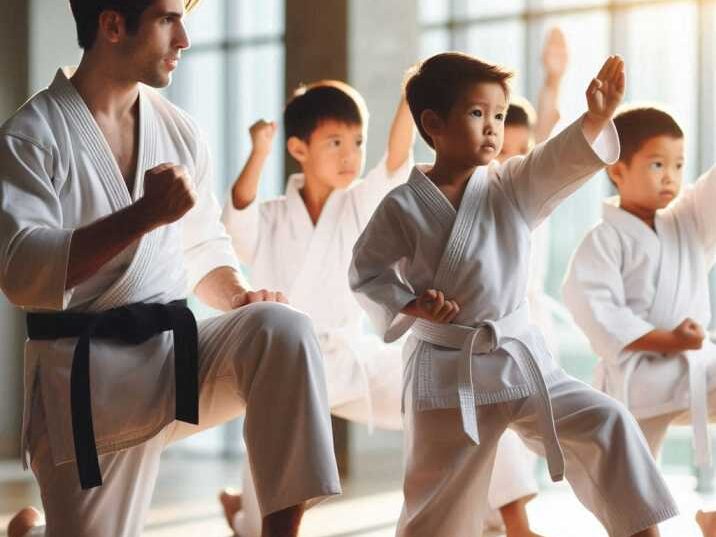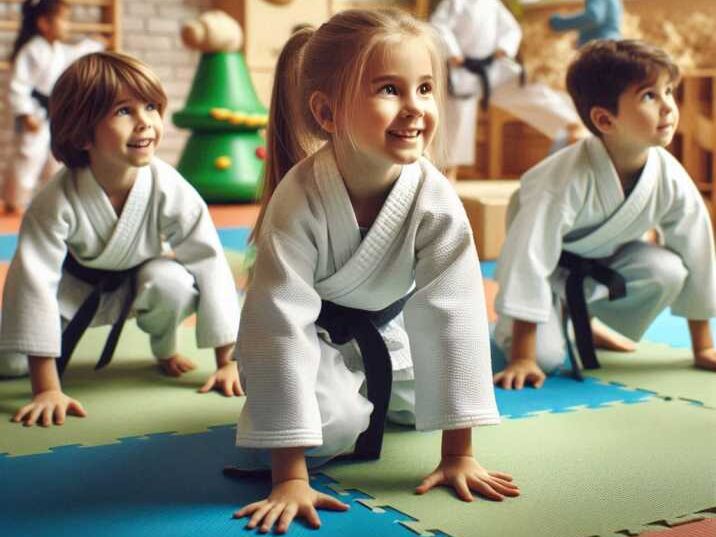Introduction
Table of Contents
Teaching kata to kids can be a fun and rewarding experience, both for the child and the instructor. Kata, a series of choreographed movements in martial arts, helps students develop discipline, focus, and coordination. This guide will walk you through effective strategies to teach kata to children, ensuring they grasp the fundamentals while enjoying the learning process.

Table of Contents
- What is Kata?
- Definition and History
- Benefits of Learning Kata
- Why Teach Kata to Kids?
- Development of Physical Skills
- Enhancing Mental Focus
- Building Confidence and Discipline
- Preparing to Teach Kata
- Understanding the Age and Skill Level
- Creating a Positive Learning Environment
- Setting Realistic Goals
- Step-by-Step Approach to Teaching Kata
- Introducing Basic Moves
- Breaking Down the Kata
- Practicing with Repetition
- Encouraging Improvement and Patience
- Making Kata Fun for Kids
- Incorporating Games and Challenges
- Using Visual Aids and Demonstrations
- Offering Rewards and Encouragement
- Common Challenges and Solutions
- Addressing Short Attention Spans
- Managing Frustration and Setbacks
- Ensuring Safety and Proper Technique
- Conclusion
- Recap of Key Points
- Encouraging Continued Practice and Growth
- FAQs
What is Kata?
Definition and History
Kata is a Japanese term that translates to “form” or “pattern.” In the context of martial arts, kata refers to a pre-arranged sequence of movements, techniques, and stances that are performed in a specific order. These movements are designed to simulate a series of combat scenarios or fights against imaginary opponents.
The primary purpose of kata is to help martial artists internalize techniques and develop their skills through repetition. Each kata consists of a set of choreographed moves that flow together in a particular sequence, allowing practitioners to practice and refine their techniques in a structured way.
Historical Context
The concept of kata has ancient roots and can be traced back to traditional martial arts in Japan, China, and other East Asian cultures. The development of kata is deeply intertwined with the history of martial arts:
- Origins in Ancient Martial Arts:
- The practice of kata likely originated from ancient Chinese martial arts, which were then introduced to Japan by martial arts masters and traders. Early kata were designed to preserve and transmit techniques and combat strategies from one generation to the next.
- Evolution in Japan:
- In Japan, kata became an integral part of the training in various martial arts such as Karate, Judo, Aikido, and Kendo. Each martial art has its own set of kata, with distinct movements and forms that reflect its unique techniques and philosophy.
- Over time, kata evolved to include more complex and refined movements. Traditional kata were often passed down orally from master to student, with each generation adding their own interpretations and variations.
- Modern Adaptations:
- In contemporary martial arts, kata continues to be an essential component of training. It helps practitioners develop discipline, precision, and mental focus. Modern martial arts schools and organizations often hold competitions and demonstrations where practitioners showcase their kata skills.
Benefits of Learning Kata
Kata offers numerous benefits, especially for children:
- Improved Coordination
- Kata involves a series of precise, coordinated movements performed in a specific sequence. As children practice kata, they learn to synchronize their actions, which enhances their hand-eye coordination and balance. This means they become better at performing tasks that require the use of their hands and eyes together, such as catching a ball or writing neatly. Improved coordination also helps in other activities, like sports and daily activities, making movement more fluid and efficient.
- Enhanced Focus
- The repetitive nature of kata requires students to pay close attention to each movement and sequence. This practice is not just physical but also mental. Children need to remember the order of moves and their correct execution, which fosters mental discipline. As they repeat the kata, they learn to block out distractions and concentrate on perfecting their form. This enhanced focus can translate to improved attention in other areas, such as schoolwork or other extracurricular activities.
- Increased Physical Fitness
- Regular practice of kata involves performing movements that require strength, flexibility, and endurance. For instance, executing various stances and techniques builds muscle strength and improves flexibility. Endurance is developed as children practice kata for extended periods. This physical activity contributes to overall fitness, helping children stay active and healthy. Improved physical fitness can also support other athletic endeavors and contribute to better overall health.
- Boosted Confidence
- Successfully learning and mastering a kata can significantly boost a child’s confidence. Each kata mastered is a tangible achievement that gives children a sense of accomplishment. This newfound confidence often extends beyond the dojo or training area, affecting their self-esteem in other areas of life. When children see the results of their hard work, they gain a sense of pride and self-worth, which encourages them to tackle new challenges with a positive attitude.
Why Teach Kata to Kids?
Development of Physical Skills
Teaching kata to kids helps them develop essential physical skills. As children practice kata, they learn to control their bodies, execute precise movements, and maintain proper posture. These skills are crucial for overall physical development and can benefit other areas of their lives, including sports and daily activities.
Enhancing Mental Focus
Kata requires intense concentration and attention to detail. By practicing kata, kids learn to focus their minds, which can translate into improved performance in school and other activities. The mental discipline gained from kata also helps children manage stress and stay calm under pressure.
Building Confidence and Discipline
Mastering kata gives children a sense of accomplishment and boosts their self-confidence. The discipline required to practice and perfect kata teaches kids the value of hard work and perseverance. This discipline extends beyond the dojo, positively influencing other aspects of their lives.
Preparing to Teach Kata
Understanding the Age and Skill Level
When teaching kata to kids, it’s essential to consider their age and skill level. Younger children may need simpler, more basic kata, while older or more advanced students can handle more complex forms. Tailoring the kata to the child’s abilities ensures that the learning experience is both challenging and enjoyable.
Creating a Positive Learning Environment
A positive and supportive learning environment is crucial for teaching kata to kids. Encourage a culture of respect, patience, and encouragement. Ensure that the training area is safe and free from distractions, allowing kids to focus on their practice.
Setting Realistic Goals
Set achievable goals for each child to keep them motivated and engaged. Goals should be specific, measurable, and attainable, such as mastering a particular kata or improving a specific technique. Celebrate progress and milestones to keep kids enthusiastic about their training.
Step-by-Step Approach to Teaching Kata
Introducing Basic Moves
Start by introducing the fundamental movements that make up the kata to kids. Break down each move into smaller components and demonstrate them clearly. Ensure that kids understand the purpose of each movement and how it fits into the overall kata.
Breaking Down the Kata
Once kids are familiar with the basic moves, break down the kata into smaller sections. Teach each section separately before combining them into the complete form. This approach helps kids focus on mastering each part of the kata before moving on to the next.
Practicing with Repetition
Repetition is key to mastering kata. Encourage kids to practice each section repeatedly to build muscle memory and improve their technique. Use drills and exercises to reinforce proper form and technique.
Encouraging Improvement and Patience
Remind kids that mastering kata takes time and practice. Encourage them to be patient with themselves and to view mistakes as opportunities for growth. Provide constructive feedback and celebrate their progress to keep them motivated.
Making Kata Fun for Kids
Incorporating Games and Challenges
Make kata practice more enjoyable by incorporating games and challenges. For example, create obstacle courses or timed challenges that incorporate kata movements. These activities make learning fun and help kids stay engaged.

Using Visual Aids and Demonstrations
Visual aids, such as diagrams and videos, can help kids understand the kata better. Demonstrate each movement clearly and use visual aids to illustrate the form. Encourage kids to watch and mimic the movements to improve their technique.
Offering Rewards and Encouragement
Reward kids for their efforts and achievements. Simple rewards, such as stickers or certificates, can motivate kids to continue practicing. Offer verbal praise and encouragement to boost their confidence and enthusiasm.
Common Challenges and Solutions
Addressing Short Attention Spans
Young children may have short attention spans, making it challenging to keep them focused during kata practice. Break sessions into shorter segments and use varied activities to maintain their interest. Incorporate frequent breaks to prevent burnout.
Managing Frustration and Setbacks
Children may become frustrated if they struggle with a particular move or kata. Address their frustration by providing additional support and encouragement. Help them break down the problem and offer strategies to overcome challenges.
Ensuring Safety and Proper Technique
Safety is a top priority when teaching kata to kids. Ensure that kids practice in a safe environment and use proper technique to prevent injuries. Supervise their practice closely and provide guidance to help them maintain correct form.
Conclusion
Teaching kata to kids is a rewarding experience that helps them develop physical skills, mental focus, and confidence. By following the strategies outlined in this guide, you can create an engaging and supportive learning environment that encourages children to excel in their kata practice. Remember to be patient, celebrate progress, and make learning fun to inspire a lifelong appreciation for martial arts.
FAQs
1. What is kata in martial arts?
Kata is a series of choreographed movements in martial arts that simulates a fight against multiple opponents. It helps improve technique, coordination, and focus.
2. At what age can kids start learning kata?
Children can start learning kata as young as 5 or 6 years old, depending on their development and interest. It’s important to choose age-appropriate kata for beginners.
3. How can I keep my child motivated to practice kata?
Keep your child motivated by setting achievable goals, incorporating fun activities, and offering positive reinforcement. Celebrate their progress to maintain enthusiasm.
4. What are some common challenges when teaching kata to kids?
Common challenges include short attention spans, frustration with difficult moves, and maintaining proper technique. Address these challenges by using varied activities, providing support, and ensuring safety.
5. How can I make kata practice more engaging for kids?
Make kata practice engaging by incorporating games, using visual aids, and offering rewards. Creating a fun and supportive environment helps kids stay interested and motivated.


